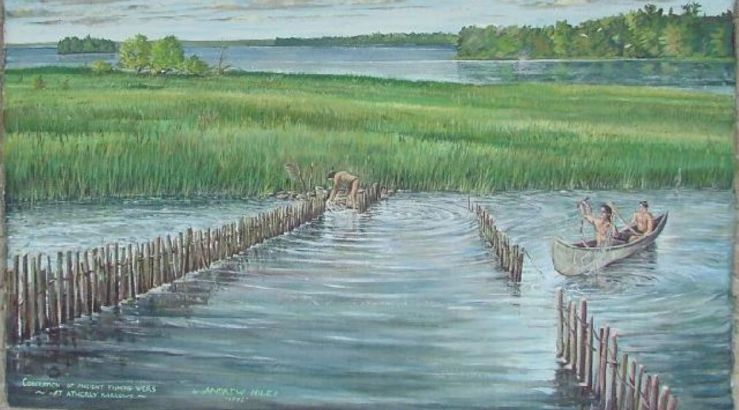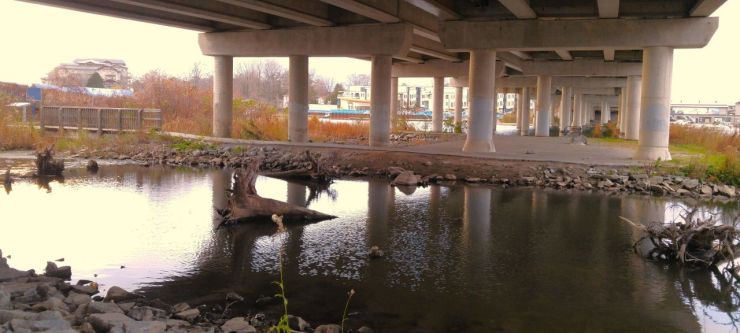In an ongoing series of “Jane Jacobs” style urban walks, Sustainability Orillia hosted two on the Day of Truth and Reconciliation in 2023. They started at the commemorative spot of the Mnjikaning Fish Weirs National Historic Site, hidden under the bridge over the narrows between Lake Simcoe and Lake Couchiching. Elder Mark Douglas from Rama First Nation welcomed the participants. He and Janice Turner, member of the Fish Fence Circle, explained the history and significance of the site. This location had been in continuous use for corralling fish (1) and holding communal gatherings for at least 5000 years.

The channel was so prized as a harvesting area, that passage through it was nigh impossible without wrecking a canoe on the stakes placed to create the weirs. Thus, the adjacent, aptly named, “Portage Bay". However, with complete disregard of the indigenous people who had always relied on this vital harvesting site, the first paddle-wheeler to visit Orillia simply churned through the narrows destroying much of the weirs in 1833. Subsequently, the channel was dredged for lumber barges and shipping. Today it is a passage for pleasure craft using the Trent-Severn Waterway, and the shoreline is being built upon, with little indication of its significance to the original people of this region.
A less than pleasant stroll across the present bridge highlighted contemporary planning issues that directly impinge on Indigenous Rights at this locale:
1. It is traditional territory of many First Nations.
2. It involves the “archaeological resources, built heritage resources and cultural heritage landscapes” (2) of those First Nations.
3. Getting across the narrows meant bridges had to be constructed in spite of the weirs.
4. The adjacent Orchard Point (traditional gathering spot) is slated for continued “intensification”.
When the current bridge was built, contemporary construction methods were proposed by the Ministry of Transportation. The First Nation opposed this as the government had promised to leave the artifacts in peace. Elders of the community negotiated with MTO to convince them to use creative construction techniques to accomplish that task.

When the first Oak Orchard Point property was purchased, the condo proposal was opposed by the neighbourhood, the City, and the First Nation. The exchange of a place of immense historic meaning for a space of misapplied density could hardly be seen as an upward trade. Subsequently, the proposal was subject to a municipal board hearing (3). Miscommunication undermined the First Nation’s presentation of their perspective on the significance of Orchard Point as a social, economic, and cultural gathering place.
Thus, the fundamental principle of talking to the people one is planning with was violated. With that precedent set other planning principles have been overlooked as development proceeds. This includes a lack of assorted destinations connected by a safe and comfortable walk; older, modest housing replaced by expensive, obstreperous architecture; density without street life; lack of pedestrian and transit groundwork paired with excess traffic; no identifiable neighbourhood centre, etc.
Emblematic of such speculation-driven, decision-making are the shallow ponds the federal government required to be built beneath the overpass in an attempt to compensate for the disruption of muskellunge (Esox masquinongy) spawning beds. They symbolise the failure to listen to the traditional stewards of this land and the channel that passed through it. What is sacred has been reduced to a monetary value. A recognition of this might be the beginning of reconciliation. So far, the muskie have not returned…
(1) Merle Assance Beedie, Elder to Beausoleil First Nation. 2002. Ontario Municipal Board evidence submission: Anishnaabe Cultural Perspective on the Natural World. OMB - May 20, 2002; Decision/Order No.: 0718; PL 001186.
(2) PROPOSED PROVINCIAL PLANNING STATEMENT, 2023. April 6, 2023.
Updated June 16, 2023 to include natural heritage policies (section 4.1) and
definitions Environmental Registry of Ontario Posting # 019-6813. [https://prod-environmental-registry.s3.amazonaws.com/2023-06/Proposed%20Provincial%20Planning%20Statement%20-%20EN%20June%2016%202023_1.pdf] 4 September 2023
(3) OMB - January 13, 2009. PL071142.
David J. Stinson; RPP, MCIP, P.Ag.; partner in Incite Planning; Board Member of the Shared Path Consultation Initiative, and recipient of 2021 OPPI Member Service Award.
Teachings
Weirs: older than the Great Pyramid of Giza in Egypt, the weirs are worthy of a UNESCO designation... so far, unsuccessful.
Fish: are considered sacred, as they have eyes near the top of their head which look to heaven. Also, they sit in council each day to decide which ones will sacrifice themselves for the survival of the humans.
Traditional Territory: ALL of Ontario is the territory of a First Nation.
Orchard Point: technically “Oak Orchard Point,”, where soaked acorns and fish meal were pounded together and dried into a nutritious travelling staple. Over time it became a Gathering Place for communities far and wide.
Promises: Given the disregard of the weirs in the past, this assurance was crucial, and demonstrates the importance of keeping promises.
First Nation: No formal consultation or accommodation of the First Nation’s interests were engaged.
Gathering Place: the Gathering Place was not protected. No space was set aside for ceremonial purposes. No plaques honouring its cultural or historic importance have been unveiled. No signs welcoming folks to this special place have been erected.
Walking Destinations: Some quick-access shops are present, but not for those on foot.
Architecture: Neither the scale nor style match the neighbourhood.
Pedestrain: the bike lanes are an affectation that no sane cyclist uses.
Transit: a bus stop is located 400 m down a busy highway.
Excess Traffic: The width & number of the five adjacent lanes, encourage both speed and volume.
Reconciliation: If two people came into conflict during their time at the Gathering Place, they were asked to leave until they were reconciled. Fish, being a sensitive species, would catch wind of the dispute and not visit the weirs. Thus, jeopardising everyone’s capacity to thrive.
